Alaska Fish & Wildlife News
September 2014
Hunting and Gathering in the Savoring Season
Autumn Lends Colorful Insight to the Last Frontier
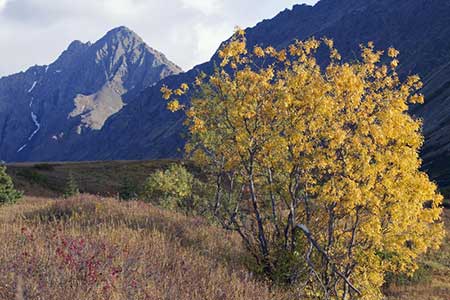
I
“Autumn is the mellower season, and what we lose in flowers we more than gain in fruits.”
– Samuel Butler
As early as the first week of August the wild raspberries are already perfectly ripe in Southcentral Alaska. Locals find them hanging in red and purple clusters from stalks that bristle with fine, hair-like spines. They sweeten the air with a fragrance reminiscent of the hot pies we’ll pull later from the oven.
Acres of raspberry bushes flank Turnagain Arm south of Anchorage; we pick them every year around this time on the hillsides and benches between the arm’s forests of coastal spruce and its rocky, tide-swept beaches. And so do the bears. Their trails are stomped like mazes into the thickets. Of course, the suggestion of lurking bruins adds spice to the event, keeps a picker alert. We talk noisily amongst ourselves and sometimes even sing aloud to mark our presence. The berries provide easy pickings for all.
On these casual outings, we might gather a couple of gallons, plenty for pie or to heat that night with a bit of sugar and caramelize into hot, tart toppings for ice cream and shortcakes. Along the way, though, the notion dawns that something more poignant is afoot than simple desserts. Clues of the day suggest, and ripe berries confirm, that times are evolving in a big, powerful way.
Ready or not, autumn has come. Clues appear daily: Days are framed by darkness now that the midnight sun has set for the year; old contrasts of brightness and shadow return. The weathers grow damp, the lands cool, the breezes turn sharply raw. And a new world blooms from the ground up.
“Autumn is a second spring when every leaf is a flower,” wrote the French author and philosopher Albert Camus.
In this far-north country, that second spring begins in August, even before the leaves turn color, with a procession of flavors that change with the advancing season. And if raspberries lure us to the departing summer’s edge, we are drawn fully into fall by month’s end when the blueberries ripen.
Wild blueberries are Alaska favorites. Ubiquitous statewide, they grow plump, sweet and profusely among the hemlocks of the southern coasts, in the Interior’s black-spruce taigas and muskegs, and throughout the alpine and Arctic tundras. Pickers mustn’t wait long into the season though, as hard frosts turn blueberries soft and saccharin.
I learned about blueberries as a young boy, while accompanying the men in my family on wilderness treks late each August and early September to hunt moose for winter meat. At the time, the 1960s, expensive beef was not a practical option for Alaska families of modest means. Much of the hunting entailed sitting silently for hours on treeless tundra hillocks, overlooking likely draws and meadows from which moose might eventually appear.
Of course, little boys were not created for long periods of silent sitting. Fortunately, those tundra overlooks often were rich with blueberries. When boredom and hunger began to gnaw, I would reach among the shrubs at my side and rake with my fingers a handful of berries. Along the way, I discovered a bite of sweet chocolate is the perfect accompaniment to a palm full of tangy blueberries.
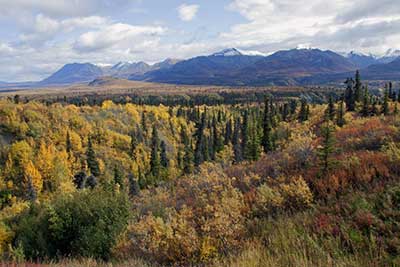
In better years, when summer rains and sunshine blend to produce bumper crops, the blueberry shrubs – rarely more than 6 inches tall in the taigas of the Copper River Basin where we hunted – droop under impressive loads, the berries sometimes seeming to rival concord grapes in size and succulence. I remember upon returning from one moose hunt my mother storming from the laundry room holding up two pair of underwear – one large (my father’s) and one small (mine). How, she wanted to know, did the white briefs she had sent us out with happen to come back with purple polka dots?
How, indeed. Clearly, a good patch of blueberries can be powerful and transforming. Ripe berries can provide measure of the advancing season, feed a yearning sweet tooth. Calm a fidgeting boy. Just take care and watch where you sit.
II
“If your mind isn’t clouded by unnecessary things, this is the best season of your life.”
– Wumen Huikai
Alaskans hunt and gather because it is our tradition and because the land is willing; even when times seem hard, say, in darkest, cold December, Alaska has a way of providing for her own. Yet of the seasons, none better define this culture of living off the country than the golden days of late August through October. Not even summer provides for its denizens more broadly or more certainly than do the days of fall.
Particularly if you look beyond the belly and into the soul.
Two Septembers ago I continued my lifelong moose hunting ways, but with a camera instead of the old Remington. Near a thicket of flaming-yellow devil’s club – thorny, waist-high shrubs with foliage resembling giant, spine-spiked maple leaves – I’d spotted a large bull with a harem of several cows. The early morning was frosty, the sun barely touching the cottonwood tops. Steam puffed from the bull’s nostrils as he jealously nuzzled his cows.
Distracted by the autumn rut, or breeding season, bull moose often discard their fear of humans. With hormone-swollen necks and menacing antlers, they strut dangerously through Alaska’s wildest corners and biggest cities alike, searching for cows – and for trouble, in the form of other bulls or anything else alive or inanimate they might perceive as a challenge. Rutting moose here are known to take on anything from mailboxes to Alaska Railroad engines.
Alaska’s fall colors reach their zenith at this time, much to the delight of photographers who travel to far-flung locations like Denali National Park and Preserve to capture dramatic images of bull moose locking antlers against the taiga’s brilliant scarlets and golds. Recently, large autumn concentrations of moose have been discovered much closer to the mainstream, on the outskirts of Alaska’s largest metropolis. Glen Alps, a gateway to Chugach State Park in the mountains backing Anchorage, now draws throngs of wildlife photographers and viewers each September and October as moose gather in exquisite high-country settings.
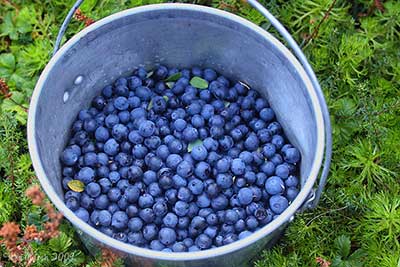
Kincaid Park in South Anchorage – a five-minute drive from Ted Stevens Anchorage International Airport – also offers superb moose viewing. The heavily wooded park is traversed by trails traveled by mountain bikers, hikers and, in winter, cross-country skiers. The trails are used by moose, too, and encounters there are frequently up-close; wildlife viewers and photographers are advised to employ due caution.
On that cold morning two Septembers ago, I watched my photo opportunity unfold: Framed by the forest’s fall colors, the bull tilted his heavy rack as he moved from cow to cow, grunting, pink tongue lolling. The cows, with dark eyes and frosty-gray coats, glided through the brush like ghosts. All the elements were there. To capture some fine, frame-filling images, I needed only stalk a bit closer.
So stalk I did. Moving when it seemed no eyes were upon me, I advanced a few feet at a time, stopping at intervals to plant my tripod and snap a shot or two. The cows seemed to ignore me completely, but now and then the bull would abruptly halt and glare suspiciously in my direction. At one point, a twig snapped behind me and I wheeled to discover a curious cow moose had sidled in to study me at arm’s length. For a moment, my heart pounded.
With little alternative, I stood my ground and the close-up cow, apparently deciding I presented no imminent danger, ambled away.
The bull, meanwhile, had turned his attention to another cow and I felt secure enough to resume taking pictures. From my viewfinder, I watched as the bull eased up to the cow and began nuzzling her flanks. The old boy had ideas, but the cow was having none of it. She bolted, leaving the rebuffed lothario standing alone and, apparently, humiliated.
In hindsight, I should have shown proper respect and stopped shooting, because when the bull heard a final “click” from my shutter release he jerked his head in my direction and focused his bloodshot eyes hard on me. I felt like I’d been marked as the third party in a soured love triangle.
Jealous and full of spite, the bull charged.
In that instant, the world faded into a yellow-and-red September-themed blur punctuated by an angry, oncoming, 1,600-pound bull moose. Nothing else existed – except for a nearby spruce that seemed to call out – not even the $3,000 worth of camera gear I left deserted on my tripod.
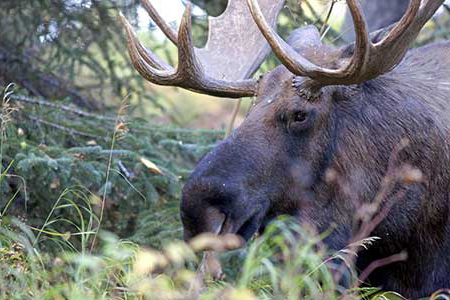
I had no time to climb the tree. Head down and foaming at the mouth, the bull was on me in a heartbeat. I dived through the low-hanging branches and placed the trunk between myself and the bull. The bull chased me around one side of the trunk, then turned and pursued me around the other. Then he stopped and, snorting and grunting, began thrashing the tree – trunk, branches, and all – with those antlers nearly six feet wide and four feet tall. I dodged as foot-long tines pierced the air inches from my face.
Something inside me seemed about to explode when, abruptly, the bull stopped, those murderous tines still inches away. I froze, afraid even to breathe. Then, as if our score were now settled, the bull lifted his head and stalked off toward the cows, never looking back.
Even in its calmer moments, autumn in Alaska imparts a sense of exhilaration – a feeling of sliding out of control down a sheer, rough slope. A round with a raging bull moose will highlight that exhilaration. It will also clear your mind.
As I gathered my gear and left on shaking legs, I breathed in the sweet-and-sour fragrance of currants and high-bush cranberries. The air felt sharply cool and the fall colors around me seemed more vibrant than ever. I was swept at that moment by a tide of joy, and by the realization that I was indeed living the best season of my life.
III
“How beautifully leaves grow old. How full of light and color are their last days.”
– John Burroughs
Transient, brief, but roaring in color; sweet with berries and alive with wild creatures, autumn in Alaska is medicine for the heart. Look for the season’s first signs in the alpine and far-northern reaches (hint: the earliest colors, some of the best, bloom near ground level – think wild rose, fireweed, bearberry). Follow autumn south with the migrating birds, and with the colors as they flow from the mountains and merge into the lowlands.
I once spent the third week of September – the heart of fall – in the Koyukuk River basin, a roadless Interior wilderness, exploring with friends. We discovered that the Koyukuk (locally pronounced Kie – ya – kuk) in autumn is a land of cool days and brittle-cold nights, the bottomlands a tapestry of oxbow sloughs and sandbars from which mammoth bones occasionally protrude. The uplands are largely boreal, a mix of spruce, birch and cottonwood trees that loom over an understory of high-bush cranberry, wild rose and other shrubs; on autumn days, the upper and lower canopies come together in watercolor bursts of purple, red and gold.
We spent the week traveling by riverboat, camping on remote sand bars, hiking trackless forests, immersing ourselves fully in the season. To my delight, I awoke each morning to howling wolves. Ultimately, though, all sounds were measured against an ancient silence; most prominent were leaves rattling down with the winds, the far-off honking of southbound swans and, at the heart of everything, the electrical surge and murmur of rivers.
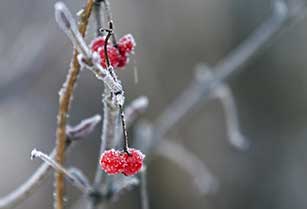
On our final day, we broke camp in a snowstorm. I remember the boat riding low, heavy with gear and campers, the river roiling black against snow-whitened banks. There on the eve of October, as flakes whirled, splattering against our faces like cold, wet kisses, I knew we had seen the last, best days of fall.
No surprise there. Autumn in Alaska develops beautifully, but swiftly; it lingers like a brilliantly colored flare, for a heartbeat or two, only to vanish as suddenly, silently and subtly as it arrived.
Berries and Beyond
Beyond the raspberries of late summer and blueberries picked prior to autumn’s first frosts, the land and the season collude to produce more berry delicacies. Hardy high-bush cranberries turn Christmas-red and ready to burst with mouth-puckering juice by early September. We crush them in colanders to remove the large, flat seeds – each berry contains one – and sweeten the juice on stovetops where it is boiled to create light, crisp jellies. Products of the boreal forests from Anchorage to Fairbanks and beyond, high-bush cranberries ripen in the first days of September; they hang ready well into winter, snow notwithstanding, welcomed as sustenance by forest grouse and frozen treats by Alaskans recreating outdoors.
Even more popular among Alaskans are low-bush cranberries, or lingonberries. Best after a hard frost, which turns them purple and sweet, these berries hug the ground on short, evergreen stalks that sprout from the sphagnums of forests, muskeg and tundra. Low-bush cranberries preserve well in the freezer, and reappear statewide at Thanksgiving and Christmas in sauces and chutneys, and as tart highlights in breads and muffins.
Too, Alaska is home to wild rosehips that grow in profusion along riverbanks and railroad beds; and crowberries – round, watery and slightly sweet tundra offerings called “blackberries” by rural people; and salmonberries that grow like enormous yellow, pink-and-red raspberries on head-high stalks in Alaska’s Southeast coastal regions; these and many other locally abundant varieties are harvested by industrious Alaskans each fall. The Alaska Dispatch recently ran an excellent primer on where to pick and how to prepare Alaska’s wild berries.
Ken Marsh is a longtime Alaska outdoor writer and serves as an information officer with the Division of Wildlife Conservation at the Alaska Department of Fish and Game. His writing and photography have been featured in dozens of magazines.
Subscribe to be notified about new issues
Receive a monthly notice about new issues and articles.
